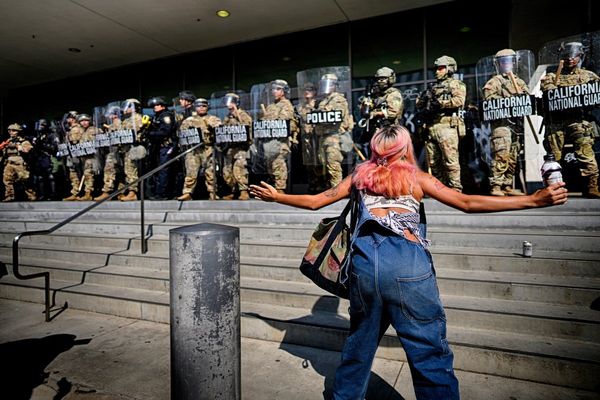
Schools in parts of Texas reopened their doors two months earlier than planned this summer. But the reason was tragic.
They were transformed into “relief hubs” to welcome volunteers whose efforts were instrumental in responding to devastating floods in the state. Now, as lessons have mostly resumed in Texas, the classrooms have been turned back from temporary emergency centres into places of learning, but that’s not to say the memories of what was lost will linger with the community indefinitely.
“In the days ahead, we will continue to stand united, working hand in hand to support our neighbors and help our community heal in the aftermath of this event,” said Sarah Nichols, the principal of Hunt school in central Kerr county, Texas.
“Our school stood as a beacon of hope, service, and resilience.”
Hunt school, which serves both elementary and middle school students, joined several others in affected areas of Texas in becoming a hub for relief and recovery in the earliest days of the flash floods. The floods, which started over Fourth of July weekend, killed at least 135 people, including many children. Authorities are still continuing to search for more than 100 missing people.
By the third day of the flooding, the Hunt campus was recast as a functioning shelter, offering food, showers and safe housing for more than 150 people at a time. It also became an operations center for several organizations such as Reach Global, Team Rubicon and Aerial Recovery. Volunteers worked to stock and distribute search and recovery supplies and provide fuel for first responders.
“The community was outstanding. If people were not affected by the flooding, they were doing everything they could to help those who were,” said Thomas McAvoy, one of the volunteers with Team Rubicon, a veteran-led humanitarian organization, who stayed at Hunt school for the duration of the recovery efforts.
“To the kids returning to school, I would firstly say thank you,” McAvoy added. “We were allowed into your space, and the few interactions we had with you, you guys were amazing. I know this was a life-changing event, but as a survivor, it will have made you stronger, and I know you will do great things to help this never happen again.”
With staff returning to the Hunt campus on 11 August and students on 20 August , the turnaround mission to get the buildings back to their original purpose was momentous. The school was still functioning as a shelter through the end of July, with classrooms acting as sleeping quarters with cots in places of desks and boardrooms as supply rooms for donated goods.
“These were not normal functions for a school preparing for a new semester, but the times called for extraordinary measures,” said Oscar Arauco, another Rubicon volunteer who was stationed at the school.
“Volunteers swept, vacuumed, moved supplies, and helped restore classrooms and facilities so Hunt school could quickly resume its primary mission: educating children.”
In times of natural disaster, it is not uncommon for schools to act as relief stations, given their range of amenities like cafeterias, gymnasiums, and shower and locker rooms.
This was the case back in 2017, when Hurricane Harvey ripped through the Caribbean and the US states of Texas and Louisiana, causing at least $90bn of damage to property and livelihoods, and killing scores of people. The storm made landfall 200 miles (322km) from Houston in August 2017 and stalled for four days, dropping as much as 60in (152cm) of rain over parts of the metropolitan area. Schools in Houston subsequently shifted their missions, acting as shelters for displaced students and their families
Other schools in Austin, Dallas and El Paso quickly followed suit, offering a haven for those facing long-term displacement. The term date for students returning to schools in these areas even had to get pushed back to as late as 5 September.
Hunt school was not alone during this disaster in its mission of turning its space into a thriving volunteer centre. The Ingram Tom Moore high school, which serves older children through grades 9-12 in Ingram, Texas, also acted similarly. In the days following the floods, the school became a hub, where anyone distributing supplies to those affected would come to collect their goods.
“We have been overwhelmed with the generosity of our community and blessed to operate in this capacity,” a representative of the school wrote in a Facebook post. “Ingram ISD continues to keep our community and everyone impacted by this tragedy in our prayers.”
Perhaps the biggest task for Hunt school and others across Texas, though, was not the gruelling volunteer work itself, or even the labour of restoring these institutions back to places of education. One significant obstacle educators now face across the country is how to deal with the children in their schools who have experienced this tragedy. How to navigate loss and grief with such a young age group.
“One of the greatest challenges will be balancing the need to continue growing our students academically while also addressing their social and emotional needs,” said Nichols, the principal.
“Together, we will ensure our students and their families have the support, resources, and care they need – both at school and at home – to feel safe, valued, and ready to learn. Our approach will be rooted in compassion, understanding, and flexibility, knowing that healing is just as important as academic growth in this season.”
According to CNN, among the 135 flood victims were two of Hunt’s youngest students. In nearby Kerrville, a teacher and coach, along with his whole family, were also killed.
In other areas, the youth death tolls were higher. Camp Mystic, the girls’ summer camp on the banks of the Guadalupe River in Texas, confirmed that 27 children and counsellors passed away in the floods.
Another volunteer at Hunt school, Jennifer Nieder, said what she would say to kids starting the academic year is that “you have an incredible community and we were lucky to be able to come in and spend some time with you.”
When asked about the challenges they may face having lost their loved ones, Nieder said: “It’s OK to not be OK.” She added: “Talk to your friends. Talk to your parents. Talk to your teachers.”







